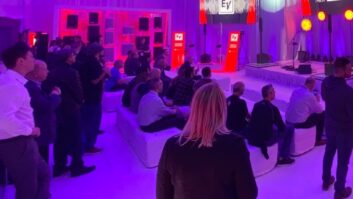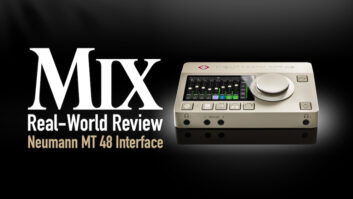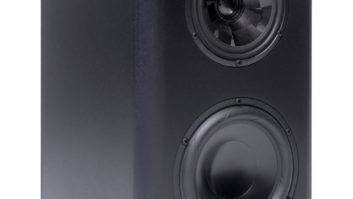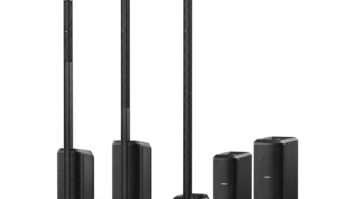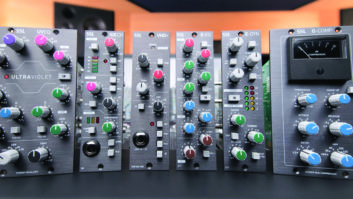
Meyer Galileo 616
Improving the sound of your live rig has never been easier. Today’s digital signal processing systems for loudspeaker control offer recallable input/output delay, system EQ, speaker-protection limiting and other features for easy-access control. Many of these all-in-one digital controllers replicate long-existing components such as compressors, delays and EQs for each crossover in a system, but that’s where simplicity comes in. Having control in a single box — rather than multiple units — can offer fast, streamlined control.
According to Howard Page, director of engineering for Clair Bros.’ Showco division, these products can both simplify life and improve a live engineer’s performance, but they must be intuitive. “Compared to the old ‘turn it on, unmute everything and away we go’ way of working, these have given us an unbelievable amount of flexibility,” he explains. “With access to loads of raw DSP power — like I have in my Clair iO unit — we can do things we never could have done with an old analog crossover. But the interface must be very intuitive. One mistake and something can happen in the system that you can’t track down without going pages deep in the operation of the units.”
We looked at some newly unveiled, recently updated and — hopefully — intuitive DSP product offerings, focusing on all-inclusive, hardware-oriented solutions. Listed alphabetically by manufacturer, these offer more simply achieved control than ever before, and that sort of thing allows us all to be both a little more comfortable and successful.
Distributed in the U.S. by Joe Desmond & Assoc., the Apex (www.apex-audio.be) Intelli-X equalizer and speaker management system was designed to complement Apex’s Intelli-Q real-time system optimizer. The 24-bit, converter-equipped Intelli-X provides four analog and digital inputs, eight analog outs and substantial DSP power. Each input offers adjustable delay, 30-band graphic EQ, 10-band full parametric EQ and two shelving EQs. The unit’s 4×8 matrix is a routing free-for-all, while all outputs offer adjustable delay, high- and lowpass filters, two shelving EQs, an 8-band parametric EQ, a fully adjustable limiter and phase reverse. All processes are always available and processing power need not be allocated. PC operation is via standard control software, which can also handle corresponding Intelli-Q units from the same computer. Its front panel includes a graphic display, metering and a headphone jack for I/O monitoring while troubleshooting.
Architectural Acoustics‘ (http://aa.peavey.com) Digitool MX is a 2U, fully programmable audio processing/control system. Features include parallel DSP processing, multilayer front panel display and multiple interface and control options. I/O includes eight balanced analog line/mic inputs with phantom power and eight balanced analog line outputs, alongside four control input ports. Two 24-bit SHARC processors provide processing power, and RS-232 and RS-485 connections provide operation and remote serial functions, respectively.

Ashly Protea 24.24M
The Protea 24.24M Matrix Processor from Ashly Audio (www.ashly.com) offers up to 24 channels of audio matrixing/processing via modular expansion cards. (The base model, 24.24M, comes in a 4-in/4-out configuration.) Each I/O card has a DSP processor to allow expansion by four channels at a time. Mic/line-switchable input channel processing blocks offer a mic preamp, phantom power, gain, delay, 15 EQ filters, gate, auto-level and ducking. Output blocks include a crosspoint mixer, highpass/lowpass filter, delay, 15 EQ filters, gain and limiter. It’s programmed using Ashly’s Protea PC system software, and 35 presets are available for setting/storing system requirements. No front panel controls are included.
Behringer‘s (www.behringer.com) Ultradrive Pro DCX2496 digital loudspeaker management system has three analog inputs — one is usable as a digital stereo AES/EBU input — and six analog outs. Features include 32-bit SHARC DSP, 24-bit/96kHz AD/DA converters and a dynamic range of 113 dB. Also available are selectable dynamic and parametric EQs, crossover filter types with selectable roll-off characteristics and delays for all I/Os.
Biamp Systems‘ (www.biamp.com) Nexia SP speaker processor is part of the Nexia family of digital audio networking systems. Geared toward fixed installs, the Nexia SP has four balanced inputs, eight balanced outs and provides a bevy of mixing, routing, combining, EQ, delay and control settings. Two 100MHz DSPs handle processing and 8 MB of memory provides 30 seconds of delay. Control and Nexia software configuration are accessible through the SP’s Ethernet port; an RS-232 port allows third-party control.
Version 2 software for BSS Audio‘s (www.bss.co.uk) lauded FDS-366 Omnidrive Compact Plus adds the first pro audio implementation of Whiseworks-Neville Thiele Method filter technology. This feature lets users increase loudspeakers’ operating bandwidths without overdriving. The Windows 2000/XP platform software also lets engineers use a wireless tablet PC with a stylus for control. The FDS-366 can drive a true stereo three-way system or three bi-amp outs for monitoring purposes. Adding extra units and MIDI slave-linking allows for up to six-way stereo systems. Also new is BSS’ Soundweb London programmable DSP/matrix systems. London offers increased I/O flexibility, dual-redundant CobraNet audio networking, more efficient DSP via Analog Devices SHARC processors and a new core system design package.

dbx 640
dbx Professional‘s (www.dbxpro.com) new ZonePro 640 and 641 Digital Zone Processors feature proprietary AFS (Advanced Feedback Suppression). According to dbx, the 640 and the blank front panel 641 are the first system processors purpose-built to deliver DSP power to the background music market, but offer the same processing engine found in dbx’s DriveRack products. ZonePro 640/641 offer EQ, dynamics processing, bandpass filtering and BGM functions such as priority override and ducking.
Version 4.1 software for JBL Professional‘s (www.jblpro.com) DSC280 Digital Controller offers both Sound Power and Venue Series tunings — two new programs for this 2U signal processor. The DSC280 features two/three/four-way operation, two parametric EQ sections for each output band, polarity invert and phase adjust on each band, overall and band-specific delay, and 60 user memories. The front panel graphic display shows all function parameters and LED output metering.
Lake Technology (www.lake.com.au) — which recently received a takeover offer from Dolby Laboratories — unveiled the Lake Mesa Quad EQ, a 4×4 digital matrix processor that incorporates the same DSP-based EQ, delay and dynamics featured in Lake’s popular Contour digital speaker processor. The Mesa Quad EQ is also supported by Lake Controller V. 3 software. Four channels of 24-bit, 96kHz converters, each with analog I/O and AES/EBU digital I/O, are included. All eight outputs of the Mesa Quad are simultaneously available to allow use as a distribution matrix.
Meyer Sound‘s (www.meyersound.com) new Galileo 616 loudspeaker management system is a 6-in/16-out, all-inclusive digital matrix processor to drive and align multizone systems. The 2U Galileo 616 employs a collection of popular features from Meyer’s analog processors such as atmospheric compensation and filters from the CP-10, VX-1 and LD-3. It can be operated stand-alone and via PC using Ethernet (Windows or Mac), and offers AD/DA conversion via 24-bit/96 kHz and 32-bit floating-point processing. Regardless of how much processing is used, Galileo 616 offers low-latency performance courtesy of its massive 1GHz vector DSP architecture.
Rane (www.rane.com) has updated the Drag Net Windows-based DSP processing and control software for its family of multiprocessors. Version 4.1 lets users update firmware, configurations and remote bitmaps over the Internet or a network. Also new from Rane is the RPM 2m, a “drag-and-drop” DSP-based programmable multiprocessor controlled via Drag Net software. Offering 24-bit converters and 48-bit internal DSP processing, the RPM 2m includes two balanced mic/line inputs with phantom power, two balanced analog outputs and an RJ-45 Ethernet connector for computer control.
Symetrix‘s (www.symetrixaudio.com) SymNet Express Series features seven models: Express 12×4, 4×12 and 8×8; and Express Cobra 12×4, 4×12, 8×8 and 4×4. The Express line is geared toward stand-alone applications in which a single unit handles all processing between source gear and the amplifiers. Along with analog I/O, Express Cobra offers an 8×8 CobraNet license that supports Peak Audio’s protocol for networked digital audio. All of the dual 100MHz SHARC-based processing units are driven by SymNet Designer’s latest V. 5 software, providing many options for system creation and control, and new software features such as additional mixers, auto firmware upgrade and a British EQ module.
A slick Live EQ available in 2/4/8-channel configurations, EQ Station from TC Electronic (www.tcelectronic.com) is now controllable from a PC via VirtualEQ Station PC application and EQ Station V. 1.5 software. The free, downloadable application allows all EQ Station parameters to be manipulated from a remote PC, while V. 1.5 software supports the EQ Station’s new digital AES I/O card. Features of the EQ Station include 6-band parametric EQ, 29-band graphic EQ, 3-band dynamic EQ, 600ms delay, a peak limiter and 250 user presets.

XTA DP6i
Distributed by Group One Ltd. (www.g1limited.com), XTA‘s new AES digital interface option can be fitted to the DP6i audio installation controller, DP224 and DP226 speaker management systems, SiDD, all Series 2 products and all OEM units. The interface includes a sample rate converter accepting AES audio streams up to 96 kHz and down to 32 kHz, and comes fitted with digital I/O. Internal processing of the XTA units remains at 48 kHz. Also new from XTA is free, downloadable software for wireless interface control for the range of the company’s AudioCore products. The upgrade allows up to 32 units to be controlled via PC using MIDI, RS-232 or RS-485 interfaces.
New from Yamaha (www.yamaha.com/proaudio) are the DME24N and DME64N Digital Mixing Engines. The DME24N has 24 mic/line I/O channels including eight analog channels and a card slot for additional digital and analog I/O. The DME64N includes up to 64 channels of I/O with four mini-YGDAI slots that accept a range of 8- or 16-channel digital and analog I/O cards. Both models feature headphone outs, four control panel options (including GPI- and Ethernet-equipped versions) and the ability to develop a complete control system by using a DME, a Yamaha PM5D digital mixing console and the 16-channel Yamaha MY16-C CobraNet YGDAI expansion card.
Strother Bullins is a North Carolina-based freelance writer specializing in the professional audio and entertainment industries.

